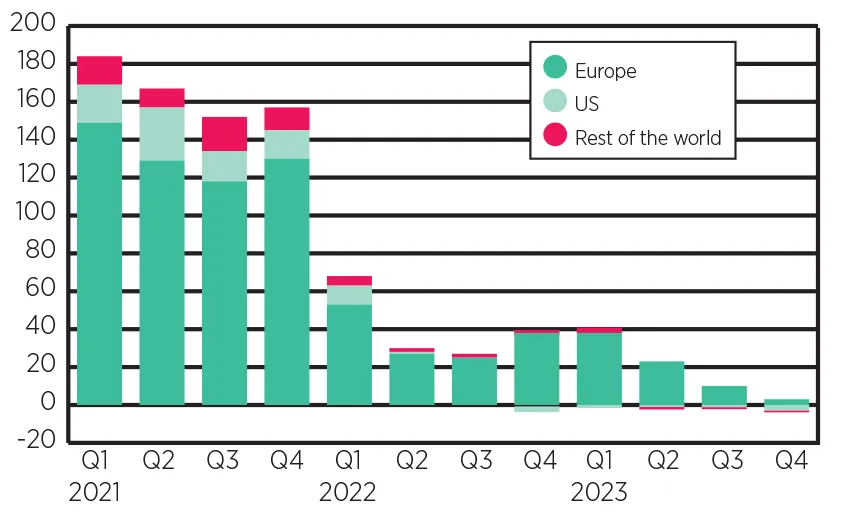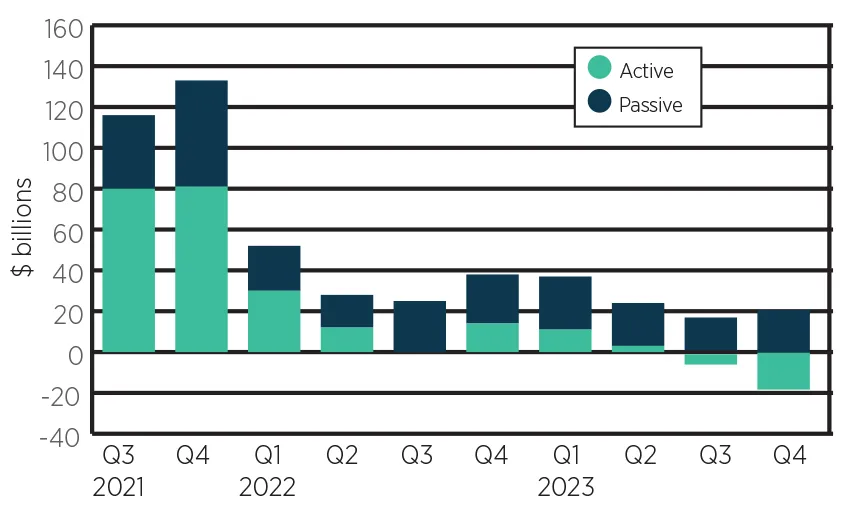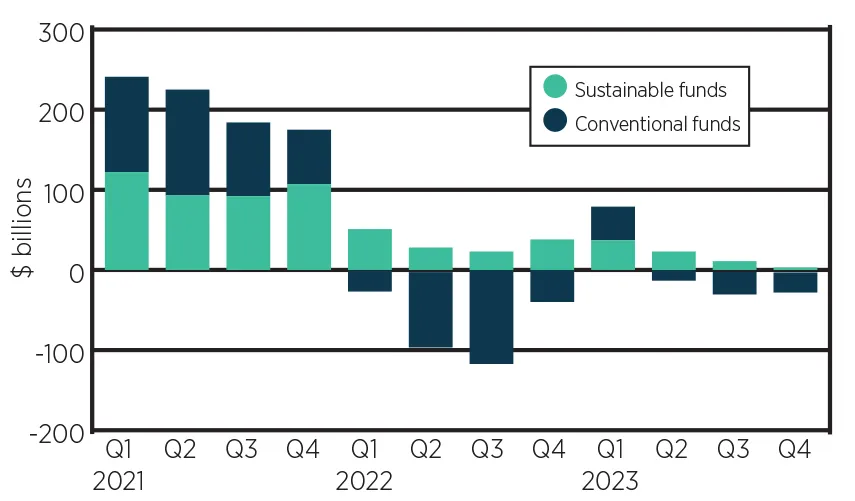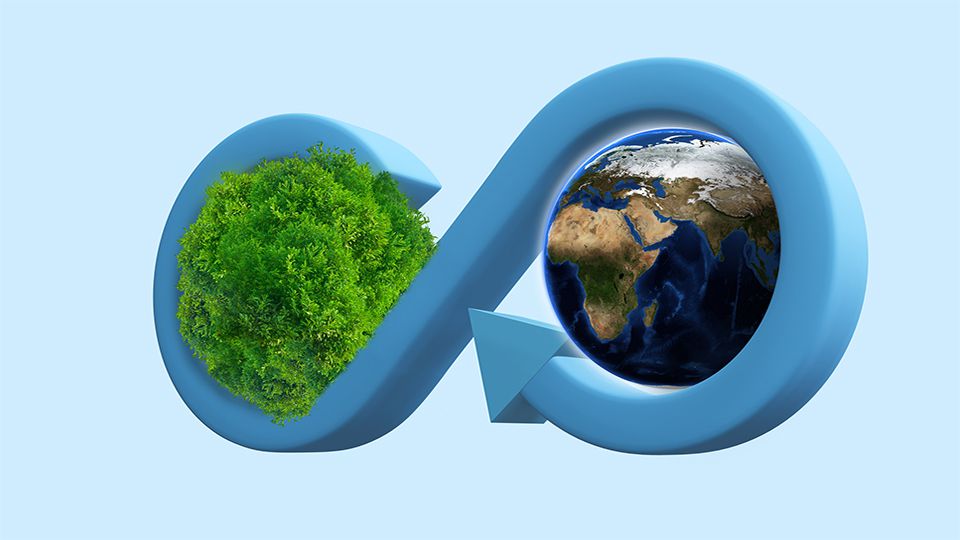Global sustainable funds saw their first quarter of outflows in the last three months of 2023, driven by an acceleration of investors fleeing ESG funds in the US and Japan.
However, in spite of a collective outflow of $2.5bn at the global level, European and Asia-ex Japan funds continued to see inflows, Morningstar’s Global Sustainable Fund Flows: Q4 2023 in Review reported.
Global assets also rose by 8.2% to $3trn amid a backdrop of market turmoil and geopolitical concerns, and there was a “minor uptick” in the number of sustainable funds brought to market around the world in Q4 – 121 were launched compared to 114 in Q3.
Hortense Bioy (pictured), global director of sustainability research, Morningstar and member of the ESG Clarity Committee, commented: “The global ESG fund flow picture in the last quarter may look bleak, but ESG funds in Europe – by far the largest market – continued to hold up better than the rest of the fund universe. Global ESG fund assets kept rising too. The disappointing reality is that active managers failed again to prevent redemptions in a corner of the market where it’s easier for them to prove their worth. By contrast, passive funds demonstrated consistent resilience.”
Quarterly global sustainable fund flows

Active managers see outflows in Europe
Despite being the biggest sustainable fund market, with 84% of the global sustainable fund assets, Europe attracted only £3.3bn in net new money in Q4, down from the $11.8bn that Europe gained in Q3.
Morningstar’s report said “the decline in subscriptions was entirely attributable to actively managed sustainable strategies” – they saw $18bn in outflows in the fourth quarter, following net outflows of $4.8bn in the previous quarter. Passives attracted net new money of $21.3bn.
European sustainable fund flows ($)

European fund flows compared with conventional fund flows

However, sustainable funds fared better than European conventional funds, which bled $25.4bn in Q4.
Over 2023 as a whole, European sustainable funds saw $76bn in inflows, down from $149bn in 2022.
“A few factors contributed to the lower inflows into sustainable funds in Europe last year,” the report said. “The challenging macroenvironment, including high interest rates, inflation and fears of recession in some parts of the world, among other implications, has led investors to favour government bonds, an area that has limited ESG products. ESG integration remains challenging in that corner of the fixed-income market – in fact, it is not feasible in the case of single-country government funds like US Treasuries or UK gilts.
“Also, it is fair to assume that some investors took a more cautious approach to ESG investing last year in the wake of the underperformance of ESG and sustainable strategies in 2022, partly due to their typical underweight in traditional energy companies and overweight in technology and other growth sectors. While the technology sector rebounded in 2023, other popular sectors in sustainable strategies continued to underperform. Renewable energy companies, for example, have been particularly affected by soaring financing costs, materials inflation, and supply chain disruptions, among other issues.”
Morningstar also flagged greenwashing concerns and the ever-changing regulatory environment as further dampeners to ESG appetite.
However, supported by price appreciation across most equity and bond markets, Morningstar noted assets in European sustainable funds rebounded to $2.5trn, a 7% increase from the previous quarter. Product development slowed in Q4 as “asset managers have been more cautious in their development of new ESG and sustainable strategies because of greenwashing accusations and the uncertainties of the regulatory environment”, Morningstar said. There were 364 launches in 2023, significantly lower than the 683 seen a year earlier.
‘Chilling effect’ in the US
Investors pulled $5bn from US sustainable funds in the final quarter of 2023, playing its part in pushing global sustainable fund flows into negative territory for the first time on record. A total of $13bn exited US sustainable funds in 2023, as the anti-ESG backlash across the pond gained further momentum.
“In addition to middling returns, greenwashing concerns persisted in the absence of clear regulation for ESG and sustainable investing,“ Morningstar commented. “Finally, the continued politicisation of ESG investing contributed to a chilling effect on demand for sustainable funds.”
Active funds accounted for 90% of the net withdrawals and Morningstar said Parnassus Core Equity – long known as the largest sustainable fund – has been one of the 10 biggest losers in terms of outflows for more than two years straight, shedding more than $4.5bn over that period.
See also: – US sustainable fund outflows accelerate in Q3 but Europe remains resilient
Despite the outflows and performance that lagged conventional peers, market appreciation pushed US sustainable fund assets higher to close out the year at $323bn. Morningstar said this is a 12% decline from the all-time high but an 18% increase from the recent low in Q3 2022.
Taiwan dominates in Asia
Excluding China, the Asia ex-Japan region recorded net inflows of roughly $1.4bn over the fourth quarter, with the highest inflows coming into Taiwan-domiciled sustainable funds.
Meanwhile, India- and Malaysia-domiciled sustainable funds saw $44m and $20m in net outflows over the quarter, respectively, with the former ending 2023 with four-consecutive quarters of outflows totalling $226m.
However, and like the other regions, total assets in sustainable funds across Asia ex-Japan climbed 5% over Q4 to $61bn, with Taiwan housing 20% of the region’s assets.
There were 29 new funds launches in Asia ex-Japan – the largest amount since Q3 2022.
Japan saw its seventh-consecutive quarter of outflows, with net withdrawals amounting to $2.4bn as passives also turned into outflows after months of outflows from largely active funds. There were also no new funds brought to market in the region in which Morningstar said was a “quiet year” for product development.
This article first appeared in our sister publication, ESG Clarity










